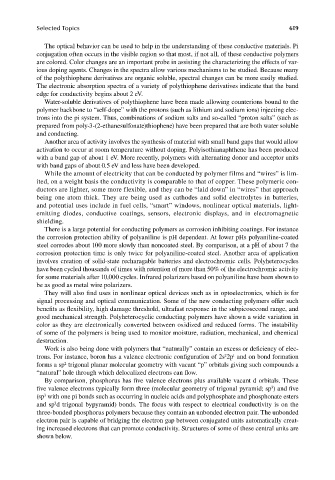Page 656 - Carrahers_Polymer_Chemistry,_Eighth_Edition
P. 656
Selected Topics 619
The optical behavior can be used to help in the understanding of these conductive materials. Pi
conjugation often occurs in the visible region so that most, if not all, of these conductive polymers
are colored. Color changes are an important probe in assisting the characterizing the effects of var-
ious doping agents. Changes in the spectra allow various mechanisms to be studied. Because many
of the polythiophene derivatives are organic soluble, spectral changes can be more easily studied.
The electronic absorption spectra of a variety of polythiophene derivatives indicate that the band
edge for conductivity begins about 2 eV.
Water-soluble derivatives of polythiophene have been made allowing counterions bound to the
polymer backbone to “self-dope” with the protons (such as lithium and sodium ions) injecting elec-
trons into the pi system. Thus, combinations of sodium salts and so-called “proton salts” (such as
prepared from poly-3-(2-ethanesulfonate)thiophene) have been prepared that are both water soluble
and conducting.
Another area of activity involves the synthesis of material with small band gaps that would allow
activation to occur at room temperature without doping. Polyisothianaphthene has been produced
with a band gap of about 1 eV. More recently, polymers with alternating donor and acceptor units
with band gaps of about 0.5 eV and less have been developed.
While the amount of electricity that can be conducted by polymer films and “wires” is lim-
ited, on a weight basis the conductivity is comparable to that of copper. These polymeric con-
ductors are lighter, some more flexible, and they can be “laid down” in “wires” that approach
being one atom thick. They are being used as cathodes and solid electrolytes in batteries,
and potential uses include in fuel cells, “smart” windows, nonlinear optical materials, light-
emitting diodes, conductive coatings, sensors, electronic displays, and in electromagnetic
shielding.
There is a large potential for conducting polymers as corrosion inhibiting coatings. For instance
the corrosion protection ability of polyaniline is pH dependent. At lower pHs polyaniline-coated
steel corrodes about 100 more slowly than noncoated steel. By comparison, at a pH of about 7 the
corrosion protection time is only twice for polyaniline-coated steel. Another area of application
involves creation of solid-state recharagable batteries and electrochromic cells. Polyheterocycles
have been cycled thousands of times with retention of more than 50% of the electrochromic activity
for some materials after 10,000 cycles. Infrared polarizers based on polyaniline have been shown to
be as good as metal wire polarizers.
They will also find uses in nonlinear optical devices such as in optoelectronics, which is for
signal processing and optical communication. Some of the new conducting polymers offer such
benefits as flexibility, high damage threshold, ultrafast response in the subpicosecond range, and
good mechanical strength. Polyheterocyclic conducting polymers have shown a wide variation in
color as they are electronically converted between oxidized and reduced forms. The instability
of some of the polymers is being used to monitor moisture, radiation, mechanical, and chemical
destruction.
Work is also being done with polymers that “naturally” contain an excess or defi ciency of elec-
2
1
trons. For instance, boron has a valence electronic configuration of 2s 2p and on bond formation
2
forms a sp trigonal planar molecular geometry with vacant “p” orbitals giving such compounds a
“natural” hole through which delocalized electrons can fl ow.
By comparison, phosphorus has five valence electrons plus available vacant d orbitals. These
3
five valence electrons typically form three (molecular geometry of trigonal pyramid; sp ) and fi ve
3
(sp with one pi bonds such as occurring in nucleic acids and polyphosphate and phosphonate esters
3
and sp d trigonal bypyramid) bonds. The focus with respect to electrical conductivity is on the
three-bonded phosphorus polymers because they contain an unbonded electron pair. The unbonded
electron pair is capable of bridging the electron gap between conjugated units automatically creat-
ing increased electrons that can promote conductivity. Structures of some of these central units are
shown below.
9/14/2010 3:43:48 PM
K10478.indb 619
K10478.indb 619 9/14/2010 3:43:48 PM

